Lists By Lukiih is readers-supported. When you buy with my affiliate link, I may earn a small commission. Thanks!
📍 Itinerary Map
This itinerary takes you to some of Thailand’s best places:
- Chiang Mai – the most popular city in the north
- Bangkok – the bustling capital city in the central region
- Krabi/Ao Nang – an area with beautiful beaches in the southern region
🇹🇭 Planning A Trip To Thailand: 12 Practical Things To Know
🗓️ Itinerary Overview
Below is a great way to spend 10 days in Thailand (see how to extend your trip). This itinerary is well-researched, highlights major attractions, and reflects lessons from my travel experience.
My Thailand trip planner has this itinerary prefilled with more details and tips.
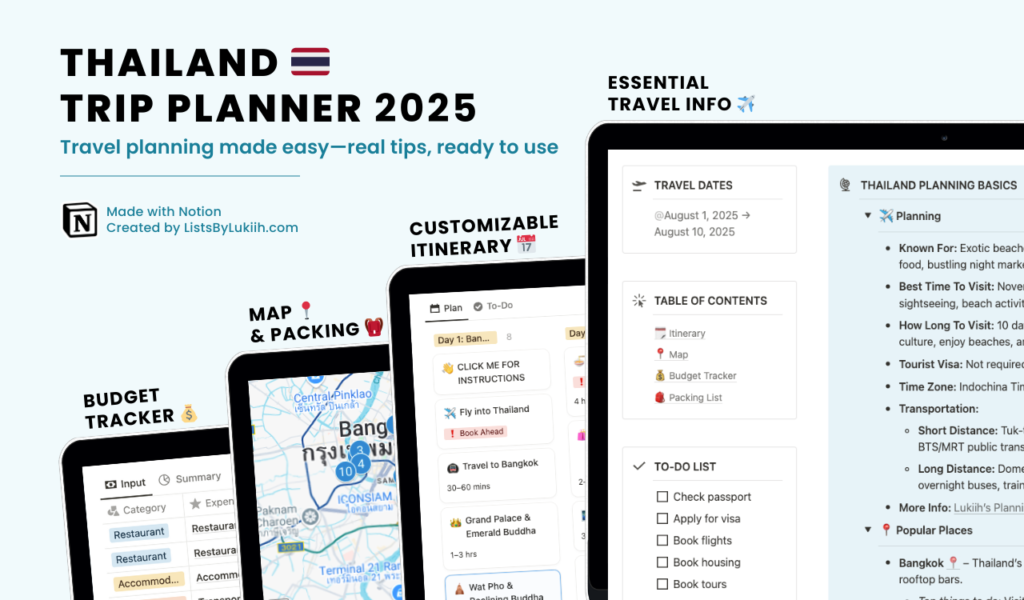
All prices mentioned here are in USD 💵 .
Bangkok (Days 1-2)
Fly into the largest city and start your Thailand trip there.
🇹🇭 Why Visit Bangkok?
Bangkok, the capital, is a metropolis known for its authentic food, street life, and nightlife. The bustling city seamlessly blends modern and traditional architecture and culture.
While spending a few days in Bangkok is typical, I recommend only two days. It’s worth a short visit, but unless you have more than two weeks in Thailand, I would prioritize visiting unique areas with more nature.
✈️ Getting to Bangkok
Bangkok has two international airports: Don Mueang International Airport and Suvarnabhumi International Airport. They’re equidistant from the city center, so you can fly to whichever is more convenient.
From either airport, you can get to the city in three ways:
- Public transportation – The Airport Rail Link is cheap and will take 45 to 60 minutes.
Bangkok also has a metro system called the BTS Skytrain. I took the airport railway and Skytrain from Suvarnabhumi Airport to get to my accommodation in central Bangkok.
- Taxis and Grab – You can download the Grab app or call a metered taxi at the airport.
- Limobus – Limobus will take you to the airport and the city in about 45 minutes. This is the most expensive option.
⭐️ Top Attractions in Bangkok
Bangkok has enough attractions that you can spend more than a week exploring them and still not exhaust all of them.
With two days in Bangkok, here’s how to see and do various famous activities and attractions.
🗓️ Day 1 in Bangkok
Here’s what to do on your first day in Bangkok:
Stop #1: Grand Palace
The Grand Palace is one of Bangkok’s most iconic landmarks. Wat Phra Kaew is the famous temple of the Emerald Buddha, a statue carved from precious green jadeite.
The Buddha is a highly revered image in Thailand, so visitors should treat it respectfully.
Stop #2: Wat Pho and The Reclining Buddha
Wat Pho, or Wat Phra Chetuphon Vimolmangklararm Rajwaramahaviharn, is a 15-minute walk from the Grand Palace and another significant complex in the capital.
It is most famous for the massive, gold-plated Reclining Buddha statue. It also has a popular Thai massage shop with a long wait (over an hour when I visited).
Wat Pho is an example of a Buddhist temple in Thailand where you’ll be required to take off your shoes before entering.

Stop #3: Muay Thai at Rajadamnern Stadium
Muay Thai, a full-contact martial art, is Thailand’s national sport. The country’s most prestigious fighters are based there, and Rajadamnern Stadium is one of the most renowned venues.
Even if martial arts is not your cup of tea, watching Muay Thai in Thailand is a unique and culturally enriching experience, as matches follow all traditional ceremonies. I didn’t think I would like it, but I would now recommend it.
🗓️ Day 2 in Bangkok
Here’s what to do on your second day in Bangkok:
Stop #1: Thai Street Food Tour
Thai cuisine is internationally renowned and one of the most flavorful in the world.
The Bangkok street food tour I went on was one of the highlights of my trip. I ate delicious and authentic food I could never order or find on my own.
It’s not uncommon for Thailand visitors to have stomach issues, so going on a food tour with a knowledge guide is also a safe way to try unfamiliar dishes.
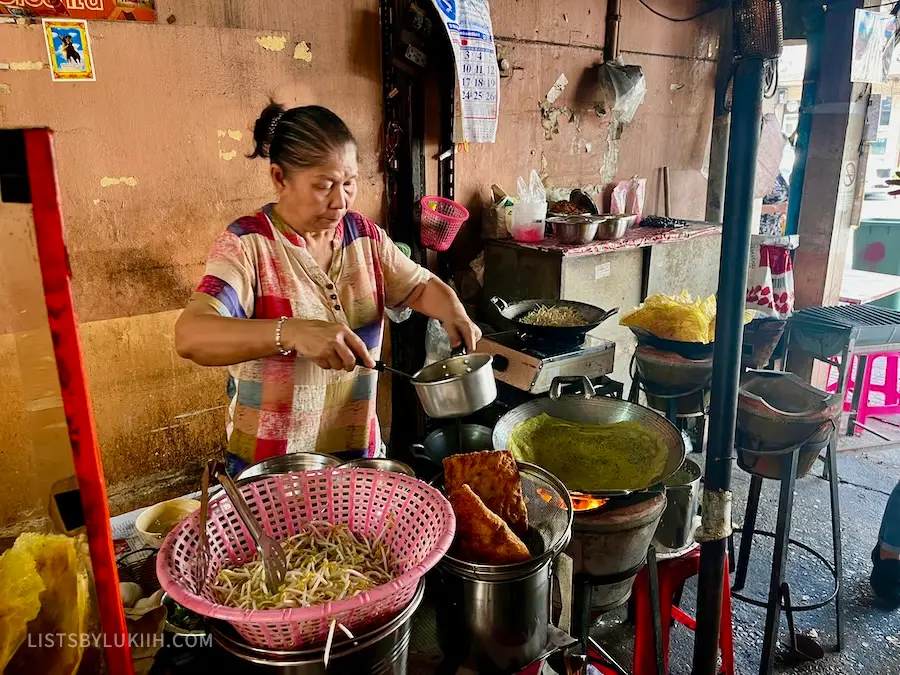
Stop #2: Bangkok’s Shopping Centers
Siam Paragon, Siam Square, and CentralWorld are three prominent shopping complexes in the city center, contributing to the capital’s reputation as an entertainment hub.
Siam Paragon is known for high-end shops and gourmet dining; Siam Square is known for its street style; and CentralWorld is one of the largest shopping centers in Southeast Asia.
If you’re visiting Bangkok on a particularly humid, hot day, the shopping centers are a great place to cool off. I visited the SEA LIFE Ocean World Aquarium for this reason and enjoyed it more than I expected.
Stop #3: Bangkok’s Chinatown
Also called Yaowarat, Bangkok’s Chinatown features ornate temples and shrines, traditional markets, and a fantastic street food scene. It’s a great place to wander around and admire the atmosphere, especially at night.
Navigating some of Chinatown’s markets and shops can be difficult if you speak only English. If you skipped the earlier food tour, consider taking a Chinatown food tour.
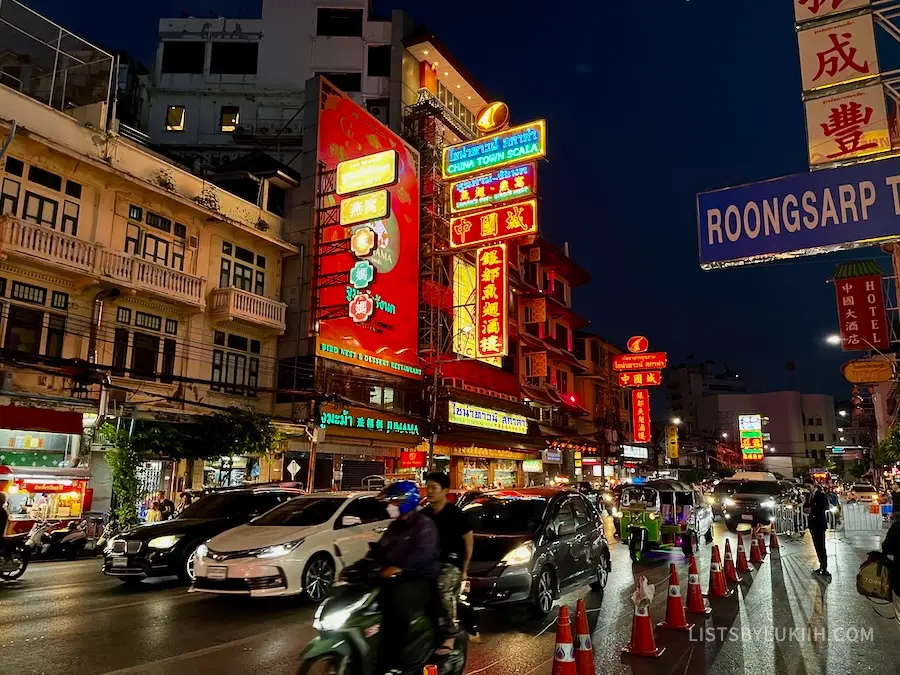
Stop #4: Wat Arun
Called the Temple of Dawn, Wat Arun is an iconic temple near the Chao Phraya River. Its striking architectural design and often lit-up exterior make it a perfect place to visit at night.
I was lucky to visit Wat Arun during Loy Krathong, a Thai festival where krathongs, typically made of flowers and banana leaves, are released into the river. It was a beautiful night with live music, dancing, and food.
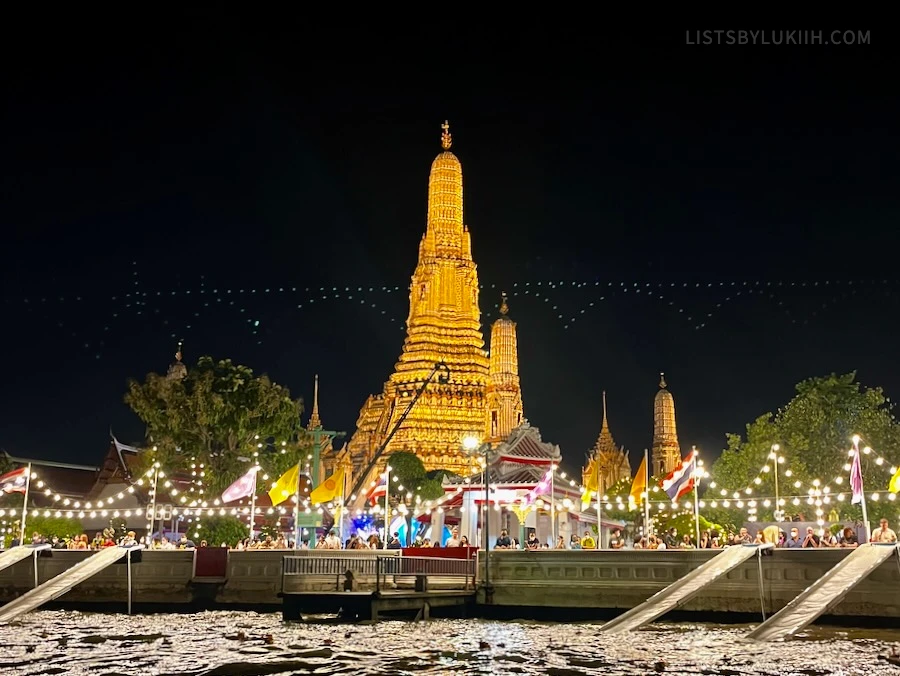
Loy Krathong is celebrated in different areas of Thailand and usually occurs in November.
Stop #5: Bangkok’s Red Light Districts
You can end your Bangkok trip with a visit to one of the notorious red light districts: Soi Cowboy, Nana Plaza, or Patpong.
These districts are famous for their go-go bars, ladyboy performers, and other adult entertainments. It was an interesting experience, although some parts felt similar to Las Vegas.
Although the red light districts are legal and designated as entertainment zones under Thai law, you should exercise caution to avoid scams and dangerous situations.
🏠 Where To Stay in Bangkok
Bangkok is a massive city with numerous places to stay:
- Sukhumvit – Well-connected, modern, and full of restaurants and nightlife, but can be busy and a bit generic.
- Old City (Rattanakosin) – Close to temples and historical sites; great for sightseeing but less nightlife.
- Silom – Balanced area with good access to both tourist attractions and public transport, though quieter at night.
Between tuk-tuks, Grab, and the city’s public transit, you won’t have trouble getting around, so stay near whichever attractions you find interesting.
I stayed at the Vix Bangkok Hotel in central Bangkok. It’s a great value hotel within walking distance of the Skytrain and some good restaurants.
🍀 Lukiih’s Tips for Bangkok
Here are my two overall tips for visiting this city:
- Beware of scammers – Thailand is a major tourist destination, and scams are to be expected. A common scam in Bangkok involves locals falsely telling you that an attraction is closed and directing you to a different place for commission. When approached with this scam twice, I ignored it and proceeded to my planned destination.
- When hailing a Grab, ride a motorbike to save time – Bangkok is a major city, so some areas have a lot of traffic. Motorbikes can weave through traffic and reach your destination faster than a car or tuk-tuk can.
A helmet is not provided if you ride a motorbike through the Grab App. I took the risk of riding it twice and felt relatively safe, but it is a risk.
- If you have extra time, visit the floating market – I’ve left a major attraction off this itinerary: Damnoen Saduak, the famous floating market. I found it far away and overly touristy during my research, so I didn’t think it was worth visiting. But you can do that to get out of the city.
Krabi / Ao Nang (Days 3-5)
On your third day in Thailand, head south to experience the beaches and islands.
🏝️ Why Visit Krabi and Ao Nang?
Southern Thailand has over 1,000 islands and is renowned for its beautiful beaches. Phuket, Koh Samui, and the Phi Phi Islands are the most popular places.
I recommend going to Krabi instead because it boasts picturesque beaches, is less crowded and is not as focused on nightlife as Phuket and Koh Samui. It’s also closer to the famous Phi Phi Islands for a day trip.
In Krabi, the Ao Nang beach area has night markets and is accessible to other beaches, islands, and hiking sites.
✈️ Getting to Krabi and Ao Nang
Fly from Bangkok to Krabi International Airport. Direct flights typically cost $35 to $60 and take less than two hours. Then, take a 40-minute pre-arranged shuttle to Ao Nang.
In Ao Nang, you can get around by renting a motorbike, hailing tuk-tuks, and taking boats to other beaches and islands. I took all three transportation methods and didn’t have to arrange them in advance.
⭐️ Top Attractions in Krabi and Ao Nang
Ao Nang is a convenient gateway to hiking sites, other beaches, and breathtaking islands.
🗓️ Day 3 in Railay Beach
After arriving in Ao Nang, take a 12-minute boat ride to Railay Beach. Last-minute tickets are available at Longtail Boat Service Club (I paid $5 for round-trip tickets). The boats leave frequently whenever they have six to eight passengers.
You have to walk into the ocean for a bit when boarding the boats, so wear sandals if you can.

Stop #1: East Railay Viewpoint and Lagoon Hike
Upon arriving in Railay Beach, you can spend several hours exploring, eating, getting a massage, kayaking, and more. For something more active, hike to East Railay Viewpoint for a gorgeous island view.
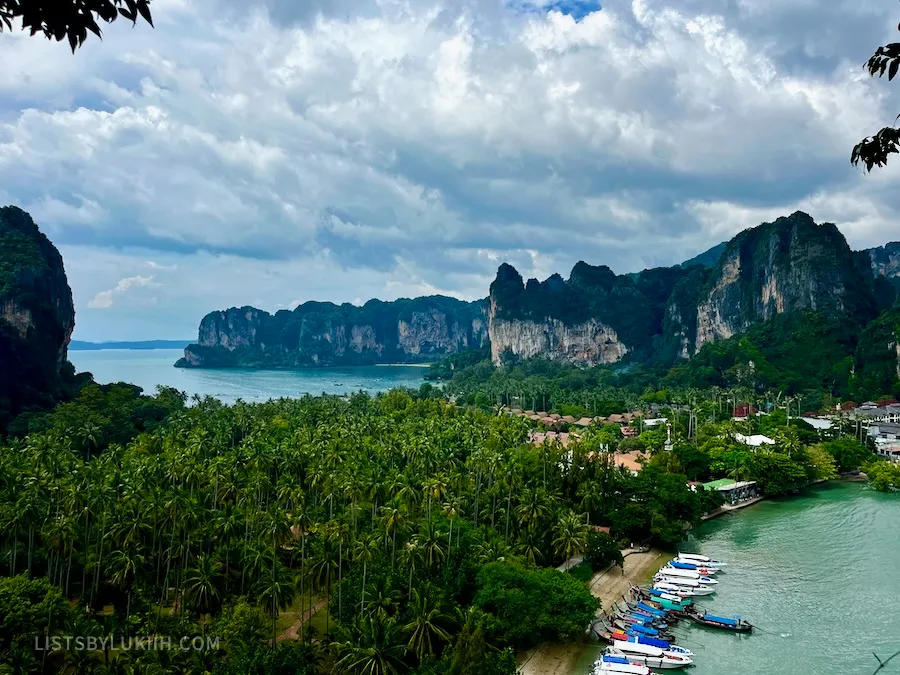
If you’re feeling adventurous, continue hiking to the Railay Lagoon. This challenging hike leads to a beautiful, tranquil lagoon where you can swim. When I did the hike, several people had to turn around; it can be treacherous near the end with steep rocks.
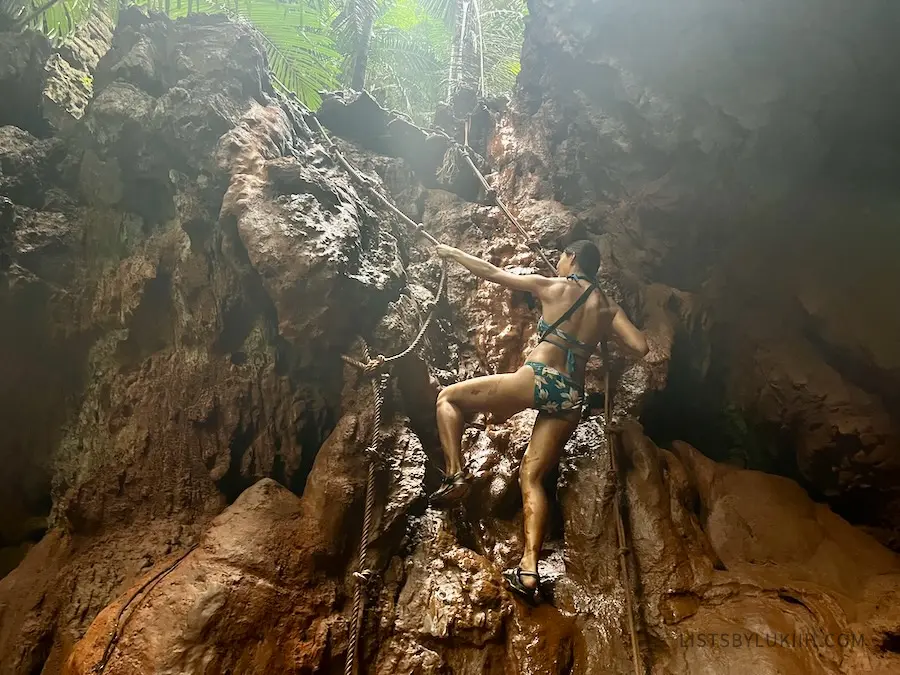
Stop #2: Phra Nang Beach
After the hike, take a short walk to Phra Nang beach. The beach is known for its white sand and proximity to caves, including the famous Princess Cave, adorned with phallic-shaped sculptures.
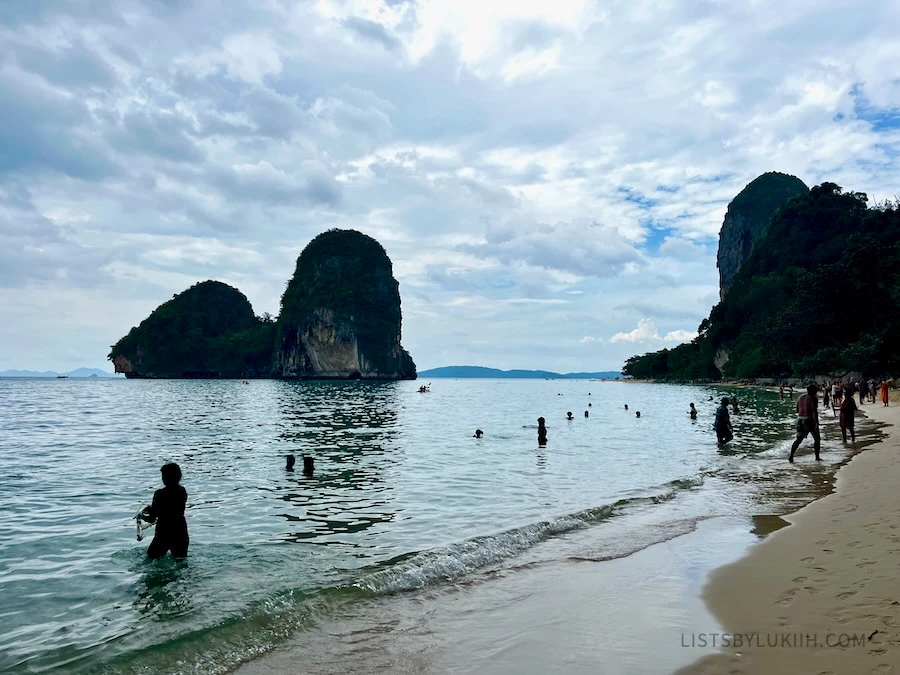
Stop #3: Ao Nang Night Market
After taking the boat back from Railay Beach to Ao Nang, settle down and make your way to the Ao Nang Landmark Night Market for a variety of inexpensive, delicious food.
I ate at this night market three times and thought some dessert stalls were exceptional (e.g., the sticky rice and mango, the Thai crepe with condensed milk).
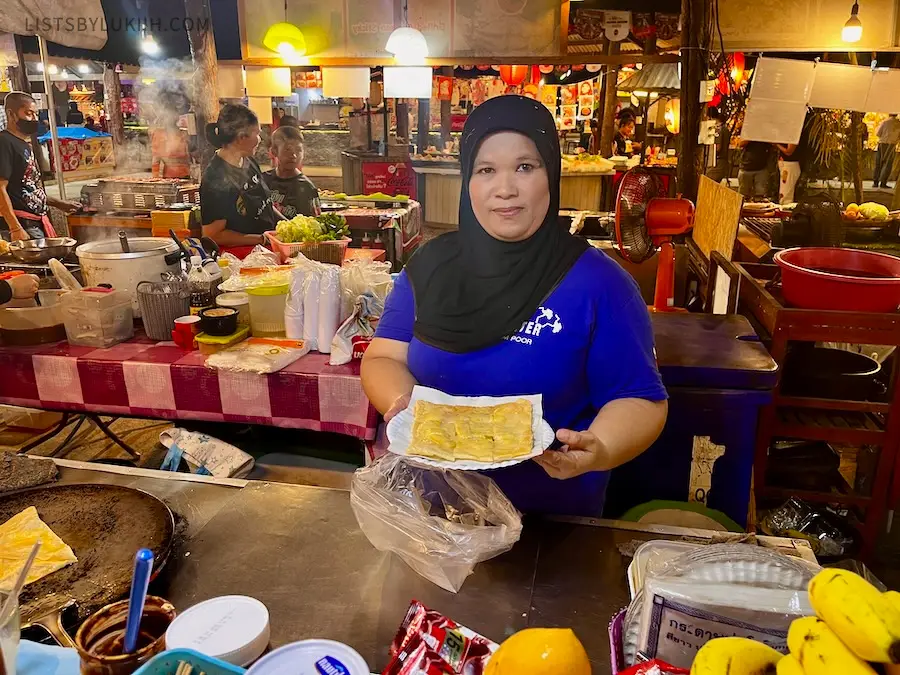
🗓️ Day 4 on the Phi Phi Islands
On your second day in Ao Nang, spend a full day at the Phi Phi Islands.
All-Day Stop: The Phi Phi Islands
The Phi Phi Islands, or Koh Phi Phi, is one of Thailand’s most famous islands because the landscape and ocean look surreal. A full-day Phi Phi Islands tour usually makes more than five stops that include:
- Bamboo Island – features crystal-clear waters you can see through.
- Maya Bay – the most stunning white sand beach I’ve ever seen.
- Ko Phi Phi Le – a popular snorkeling place.
Expect every Phi Phi Island stop to be extremely crowded. Swimming is prohibited in Maya Bay since tourism is eroding the corals. The government also closes the bay every year in August and September.


🗓️ Day 5 in Railay or Ao Nang Beach
On your last day in Krabi, you can relax in the Ao Nang area or return to Railay Beach.
Option 1: Relax at Ao Nang
Stay in the Ao Nang Beach area to get a massage (I got a massage at this place), kayak, take a Thai cooking class, walk along Khlong Hang Road, or relax by the beach.
Option 2: Rock Climb at Railay Beach
Alternatively, you can return to Railay Beach to rock climb, which is what I did. I climbed with Hot Rock Climbing School, which I highly recommend.
The views from the top of the climb were breathtaking, but the tide started receding around 2:30 pm, which made the views less pleasant as the day went on.
You can also take beginner’s rock climbing classes at Railay Beach if you don’t have previous experience.
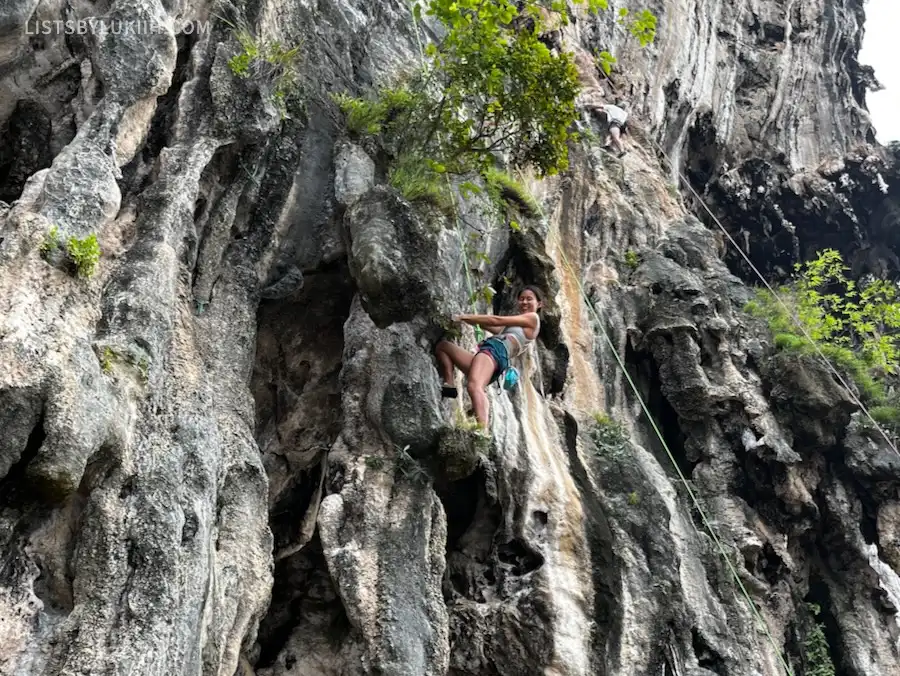
🏠 Where To Stay in Ao Nang
Ao Nang is a small town where you can stay close to the beach or further away.
Staying close to the beach makes visiting other beaches and islands convenient. Alternatively, you can stay further away on Khlong Hang Road like I did, in which case you will need transportation to get to the beach.
I stayed at the Sea Condo because I needed a place with laundry. The room was quiet, clean, and spacious. If I hadn’t needed laundry, I would have liked to stay closer to the beach in a place like The Dream Garden.
🍀 Lukiih’s Tips for Krabi and Ao Nang
Here are my two overall tips for visiting this area:
- It’s a great place to rent a motorbike – If you don’t have motorbike experience but want to drive one in Thailand, Ao Nang is a good place to do it since the streets are manageable and not crowded. (Bangkok would be hectic and dangerous.) I rented one for cheap and found it convenient to get around.
- You can eat at the night market every night – The area has plenty of restaurant options, but the night market is also large and diverse enough that you won’t get tired if you eat there three times like I did.
Don’t confuse the primary night market, Ao Nang Landmark Night Market, with smaller markets with several food stalls.
Chiang Mai (Days 6-10)
On your sixth day, fly into Chiang Mai, my favorite place in Thailand.
🐘 Why Visit Chiang Mai?
Chiang Mai is Northern Thailand’s most famous destination and many visitors’ favorite city, including mine.
The city is known for its ancient temples, elephant sanctuaries, and the cultural city center called Old City. It also serves many unique Northern Thai dishes from the region.
✈️ Getting to Chiang Mai
Fly from Krabi’s airport to Chiang Mai’s international airport. Direct domestic flights are typically under $60 and take less than two hours.
From the airport, you can take a 15-minute taxi into Chiang Mai. When I visited, getting a cab was cheaper than calling a Grab.
Once in Chiang Mai, you can get around by Grab, tuk-tuk, or songthaew, a red passenger vehicle.
⭐️ Top Attractions in Chiang Mai
I spent five days in Chiang Mai and could have stayed longer because of the abundance of things to do, see, and eat.
🗓️ Day 6 in Chiang Mai
See at least one famous temple during your first day in Chiang Mai.
Stop #1: Khao Soi for Lunch
Northern Thailand is known for its distinct cuisine, and khao soi is one of its most famous dishes. It is a yellow curry noodle soup with a creamy texture and a slight kick.
There are several places to get khao soi. I had a delicious $2 bowl at Khao Soi Arak, a hole-in-the-wall restaurant specializing in this dish.
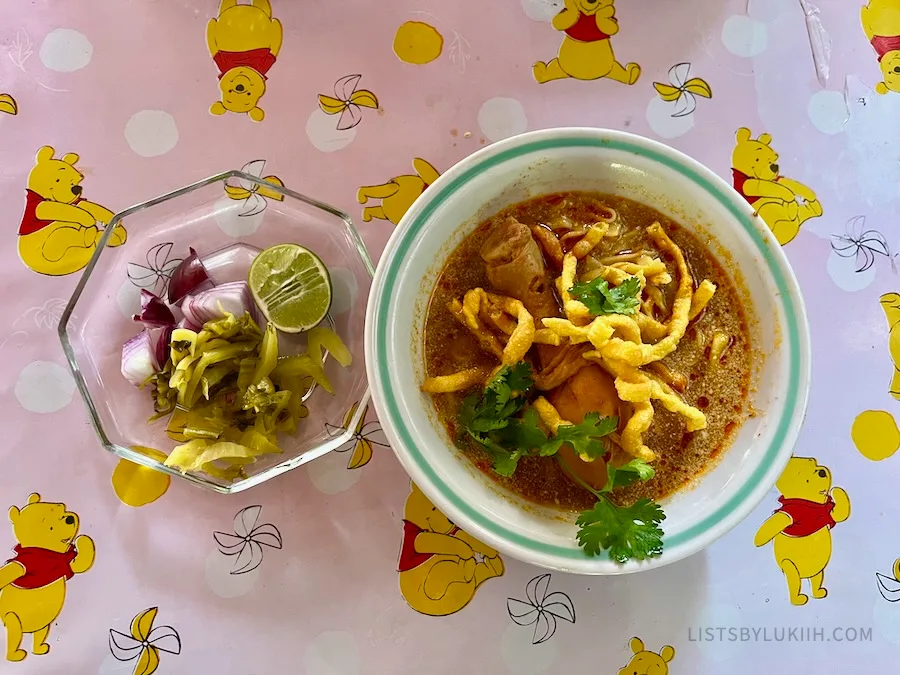
Stop #2: Temple-Hopping in Old City
The cultural and historic center of Chiang Mai is Old City, which has over 300 beautiful temples. Although you can spend days admiring their architecture and decorations, I recommend visiting only a few temples daily so you don’t get tired of them.
I researched over 50 temples and prioritized seeing the gold-plated Wat Phra Singh Woramahawihan and the unique Wat Lok Moli. I spent 30 to 45 minutes at each one.
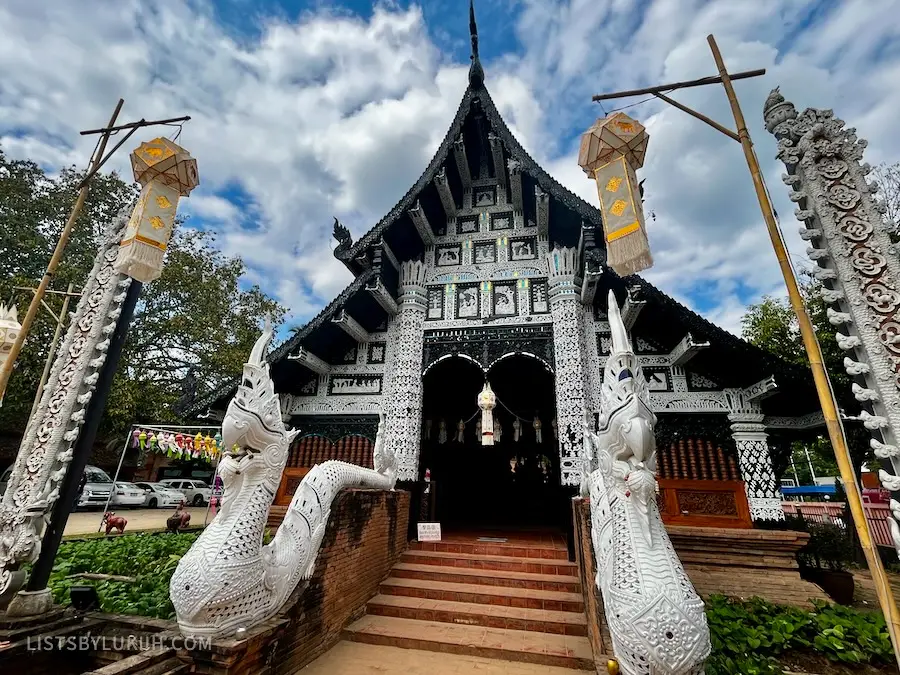
Stop #3: Monk’s Trail to Doi Suthep
Catch the sunset at Wat Phra That Doi Suthep, one of Thailand’s most revered and sacred temples. It’s on the mountain, Doi Suthep, so the temple offers panoramic views of Chiang Mai and the surrounding countryside.
Monks pray daily at Wat Doi Suthep right before sunset. When I visited in November, prayers started at 5:30 pm.
To reach Doi Suthep, you can catch a ride up the mountain or hike up Monk’s Trail like I did.
Monk Trail passes through a smaller, tranquil temple called Wat Phra That. The path from the trailhead to the smaller complex is beginner-friendly. The route from the smaller temple to Doi Suthep is steep but worth it.
If you’re doing the hike, make sure to bring bug spray, as there are a lot of mosquitoes. I packed my insect-repellent lotion, which I prefer over the spray kind.
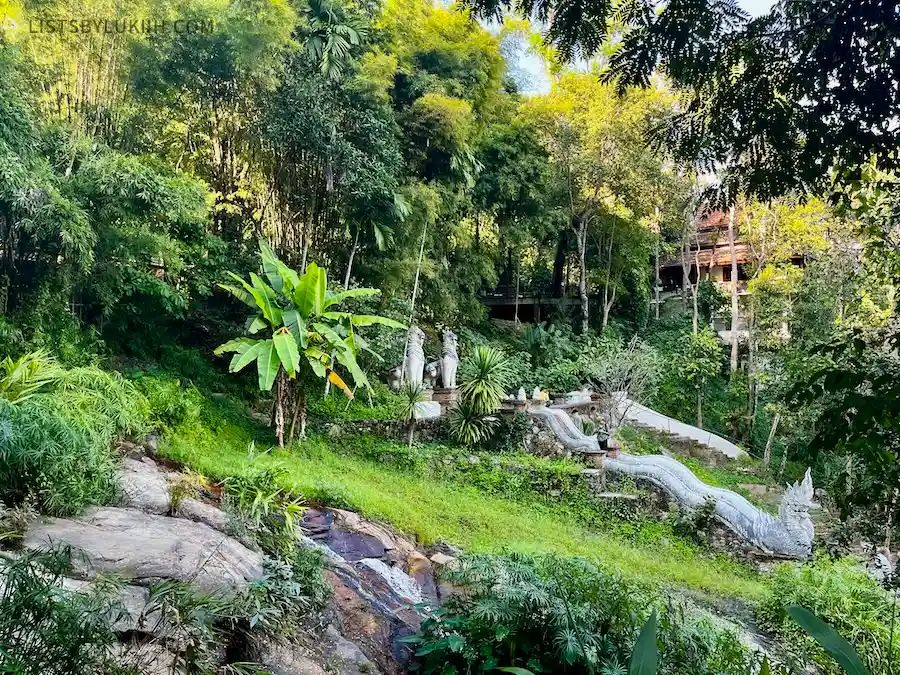
Stop #4: Chang Phuek Night Market
For dinner, you can go to a local restaurant or check out the Chang Phuek Night Market on the north border of Old City. The market has plenty of food stalls to choose from.
Chang Phueak Pork Leg Rice serves a delicious rice dish and is one of the most famous food vendors at the night market. Look for a lady wearing a cowboy hat.
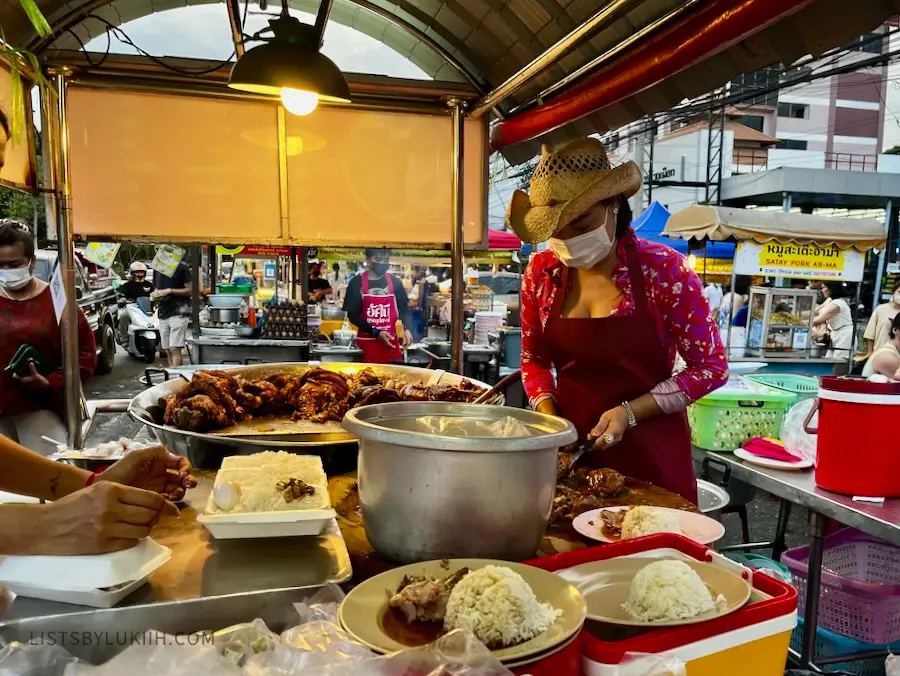
🗓️ Day 7 in Chiang Mai
On your second day in Chiang Mai, spend the day visiting an ethical elephant sanctuary.
All-Day Stop: Ethical Elephant Sanctuary
Elephants have played an important role in Thai society and history. One of the country’s most well-known activities is seeing these majestic creatures. I had the best time visiting an elephant sanctuary in Chiang Mai.
Elephant Nature Park is Thailand’s best and most ethical elephant sanctuary. Reservations are usually booked one to three months in advance, so it’s best to book early.
🐘 Elephant Sanctuaries in Thailand: Honest Review & Tips
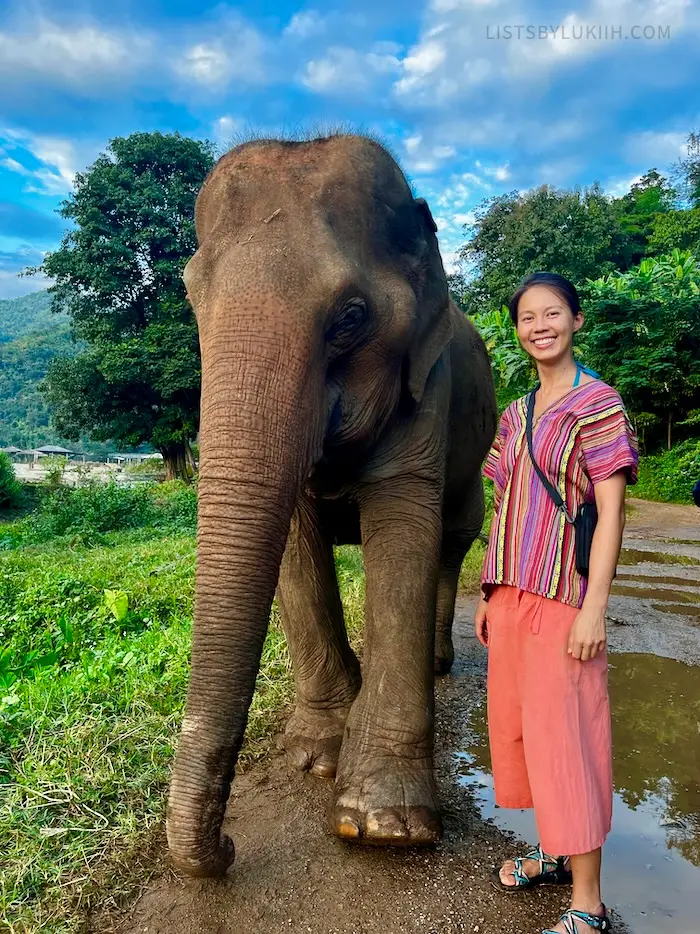
🗓️ Day 8 in Chiang Mai
On your third day in Chiang Mai, do more activities the city is known for.
Stop #1: Old City and More Temples
Spend your morning visiting a few more temples in Old City before the afternoon heat. Some notable temples to check out include:
- Wat Chiang Man – the oldest temple in Chiang Mai.
- Wat Inthakhin Sadue Muang – a dark temple with gold accents.
- Wat Saen Mueang Ma Luang – a temple in Lanna style, which typically features multi-tiered roofs.
Stop #2: Monk Chat
After lunch, have a unique conversation at a monk chat. Several temples around Chiang Mai hold monk chats, where visitors get to talk to local Buddhist monks in a casual environment.
👲🏻 Monk Chats in Chiang Mai: Honest Review & Tips
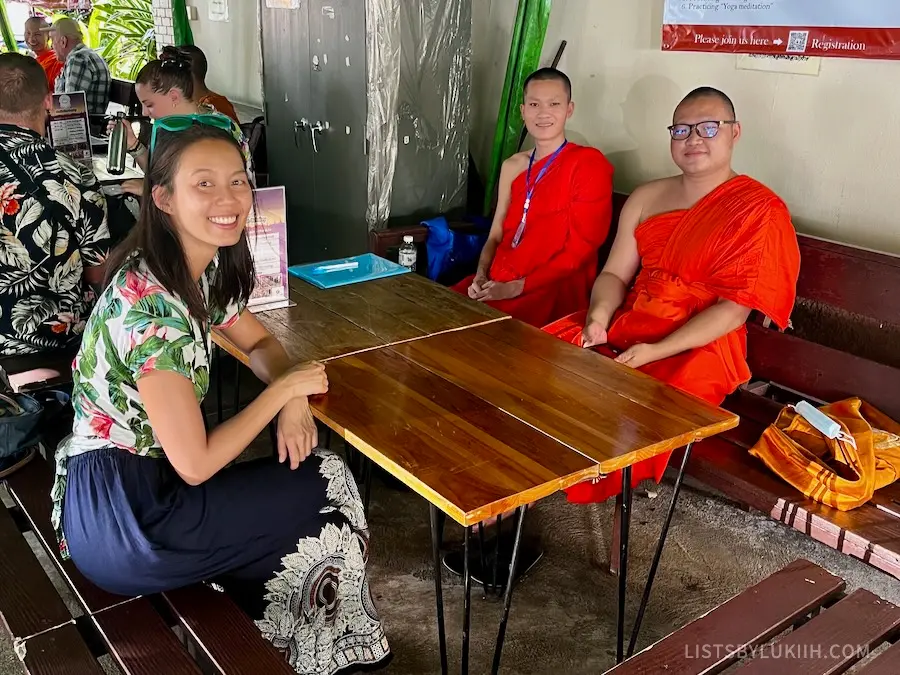
Stop #3: Traditional Thai Massage
There are an endless number of businesses around Chiang Mai that offer massages. A unique place to get a traditional Thai massage is at Chiang Mai Women Correctional Institution Vocational Training Center.
The center trains and employs imprisoned women, allowing them to earn money. It has a small attached museum that explains why some of these women are imprisoned, which includes convicts who acted in self-defense.
The Chiang Mai Women Correctional Institution Vocational Training Center is incredibly popular. Go around lunchtime to join the waitlist. I waited an hour and a half for a fantastic massage.
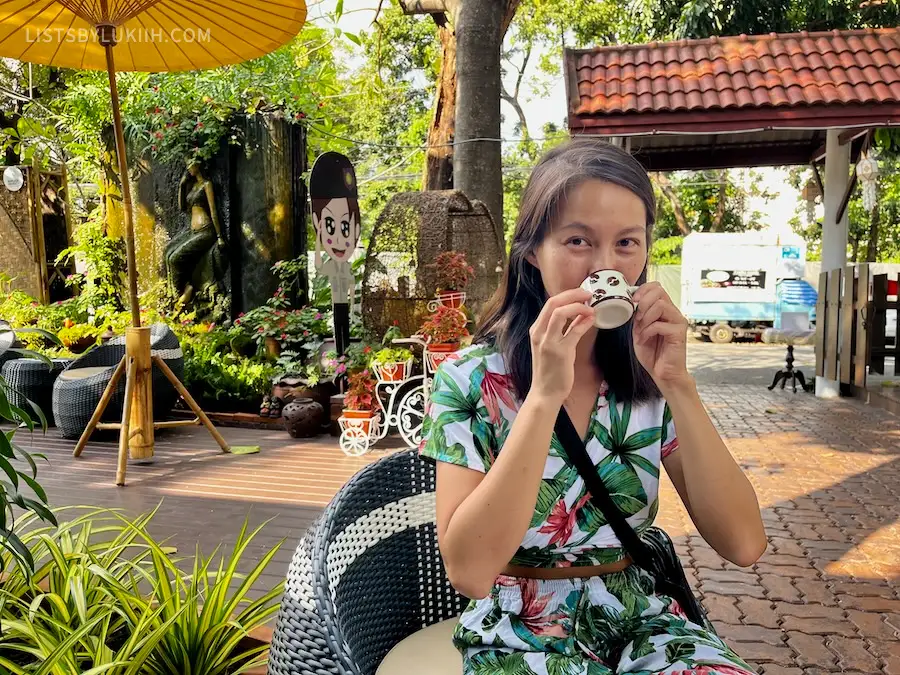
Stop #4: Northern Thai Food Tour
Northern Thai cuisine is unique and has its distinct dishes. I went on this incredible Northern Thai food tour, where I had the best pork belly of my life and learned about popular noodle dishes I’ve never had before.
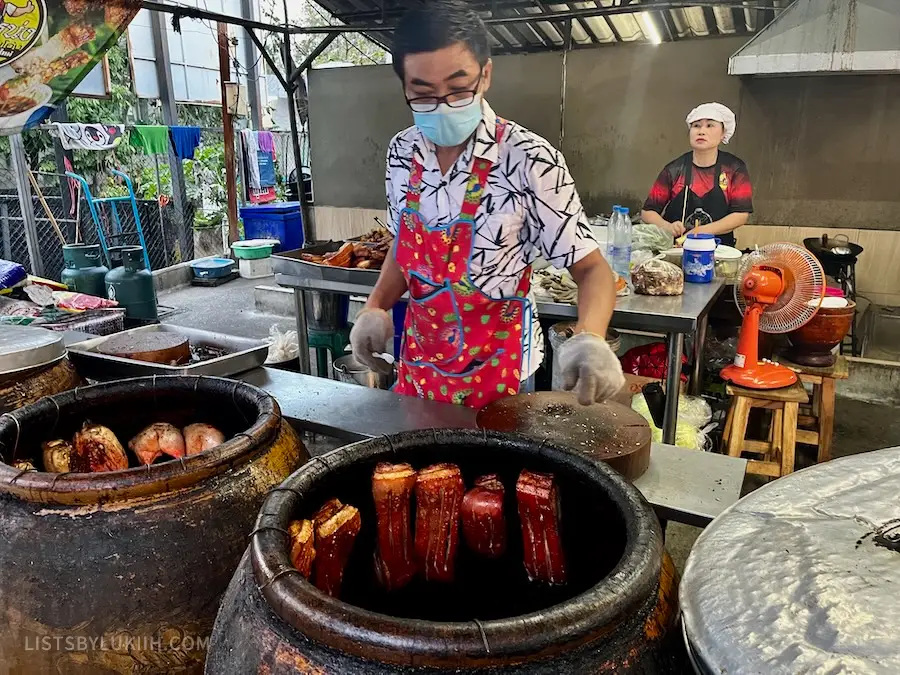
Stop #5: Cabaret Show
Chiang Mai has a few fun cabaret shows featuring drag queens performing and singing popular hit songs.
I attended the Chiang Mai Cabaret Show, but there are other shows, such as the 6ixcret Show and the Siam Dragon Show.
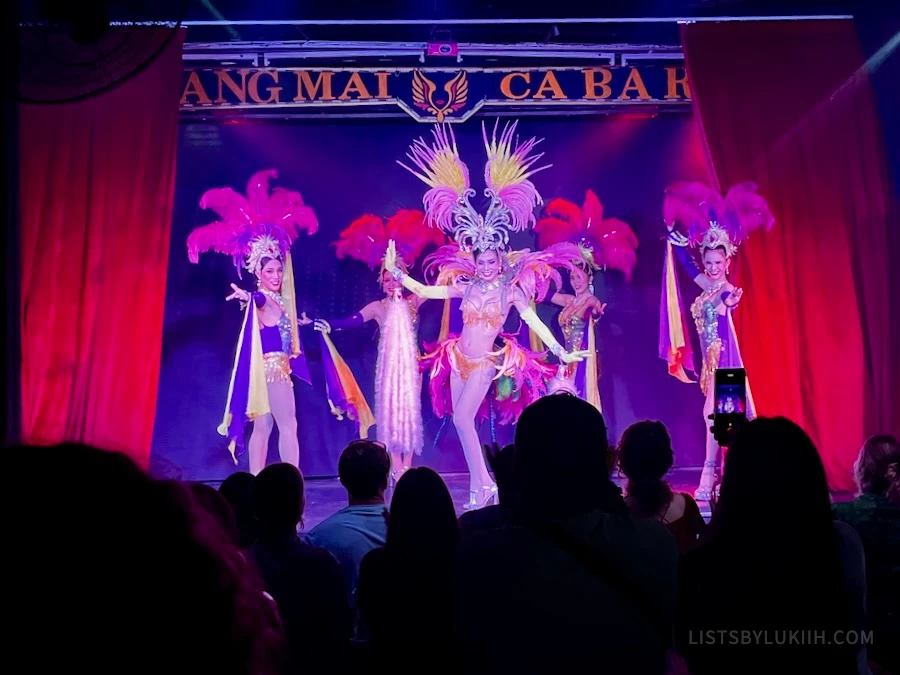
🗓️ Day 9 in Chiang Mai
On your second-to-last day in Thailand, choose your own adventure. Doi Inthanon National Park is great for nature lovers, and Chiang Rai is a great choice for those who love temples.
Option 1: Doi Inthanon National Park
Take a full-day trip to Doi Inthanon National Park, which is on Doi Inthanon, the highest mountain in Thailand.
The park features spectacular views, hikes, waterfalls, bird-watching opportunities, pagodas, and a cooler climate.
You can visit Doi Inthanon on an organized tour or independently. If you want to avoid taking a tour, you’ll need to book a two-hour transportation from Chiang Mai.
Option 2: Chiang Rai
One of the most popular day trips from Chiang Mai is Chiang Rai. The city is known for its unique temples and proximity to the Golden Triangle, where the borders of Thailand, Laos, and Myanmar meet.
Chiang Rai’s most famous attractions are the visually stunning Wat Rong Khun (The White Temple), Wat Rong Suea Ten (The Blue Temple), and Baan Dam Museum (The Black House).
🗓️ Day 10 in Chiang Mai
On your last day in Thailand, you can visit one more famous attraction before departure.
Stop #1: Sticky Waterfall
Take a trip to Sticky Waterfall, also called Bua Thong Waterfall, a unique natural attraction surrounded by lush rainforest. The calcite deposits make the rocks in the waterfall rough and grippy, so visitors can walk on the waterfall without fear of slipping.
The Sticky Waterfall is an hour from Chiang Mai, so I was hesitant about making the trip, but I am so glad I did. It’s a unique experience, and the multi-tiered waterfall has several places to explore.
You can take a small-group Sticky Waterfall tour that provides transportation or hire a driver to get there.
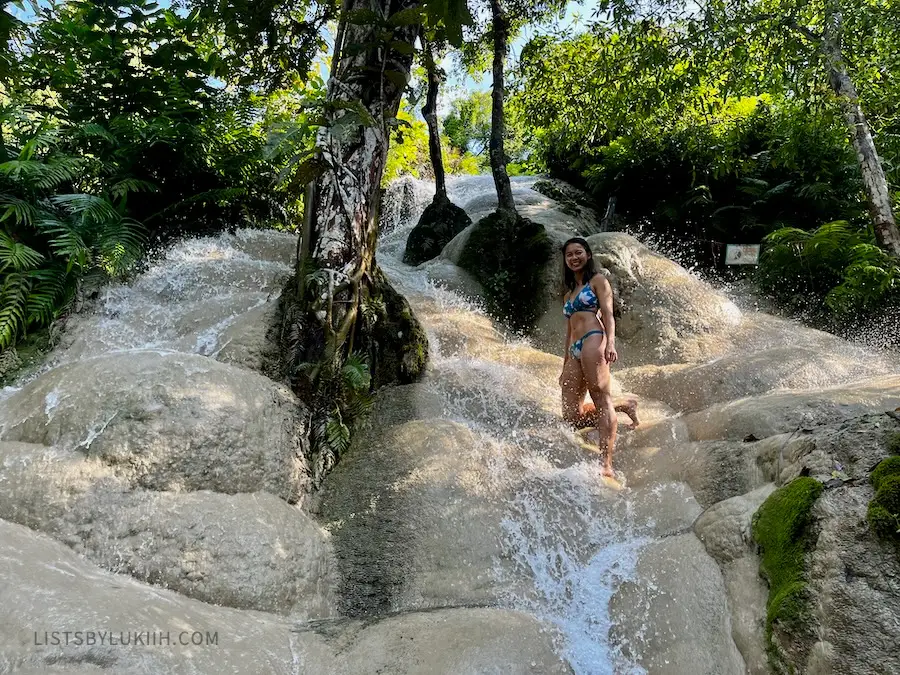
Stop #2: Departure
Fly out of Chiang Mai’s airport to go home or to your next destination!
🏠 Where To Stay in Chiang Mai
Chiang Mai has several places to stay for visitors:
- Old City – This is where most first-time visitors stay. It’s central, walkable, and close to many temples and café.
- Nimmanhaemin – A trendy area west of Old City with boutique shops and modern coffee culture. It’s quieter but less traditional.
- Riverside – This area is more scenic and peaceful with boutique resorts, but it’s farther from main attractions.
If this is your first time visiting Chiang Mai, consider staying inside the Old City’s walls. You’ll be at the center of all the action and within walking distance of many temples, restaurants, and massage places.
I stayed next to this hotel in Old City and loved being close to temples and restaurants while being in a somewhat hidden, quiet location.
🍀 Lukiih’s Tips for Chiang Mai
Here are my two overall tips for visiting this city:
- Don’t overwhelm yourself with temples – Chiang Mai has hundreds of them, and you might think you’ll want to see several per day. But you can quickly get “templed-out,” so aim for two to four temples at most daily to appreciate each one.
- Find local restaurants – I ate at two tourist restaurants and otherwise at local places and night markets. The food at local restaurants was far better and cheaper. My best find was ร้านแม่บุปผา, a small, local restaurant that I ate at three times.
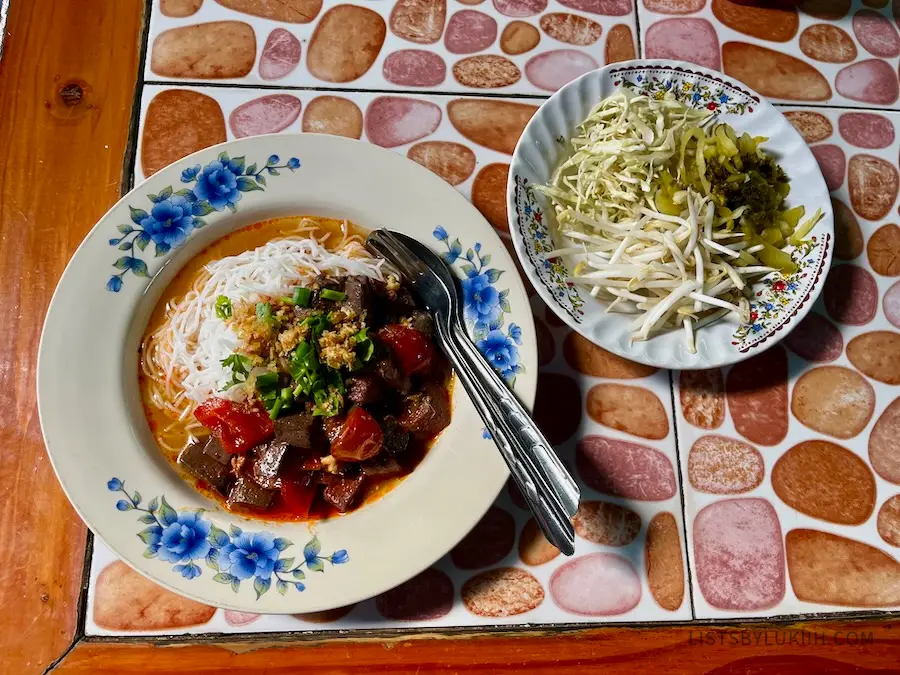
💰 My Thailand Trip Cost: Budget Breakdown (2025)
With More Time: 2-Week Itinerary for Thailand
If you have extra days in Thailand, extending your stay and modifying the itinerary above is easy.
If you have fourteen days in Thailand, I would extend my time in Bangkok by a day and spend the other extra days in the southern region. You can visit more beaches and areas in Krabi or fly to one of the many other islands.
Here’s a great two-week Thailand itinerary for first-timers:
- Bangkok – 3 days
- Ao Nang, Railay Beach, Phi Phi Islands – 3 days
- Another southern area (e.g., Phuket, Koh Samui, Koh Lanta, Koh Phangan) – 3 days
- Chiang Mai – 5 days
Thailand Trip Planner 2025
Make planning easier with my flexible, research-backed travel planner—shaped by real experience. It has:
- Up-to-date travel info
- A well-curated itinerary
- Practical, firsthand insights & tips
- A simple budget tracker
- A starter packing list
- Fully customizable sections
Built in Notion, this is the tool I personally use to plan every trip. I genuinely love it and creating a Notion account is free.
Lists by Lukiih is a small site I fund myself. Downloading my trip planner is the best way to support me and keep it running—thanks!

